In the modern educational landscape, there is a prevalent need for teachers to set clear, measurable objectives. One popular technique that is gaining traction in educational institutions across the globe is the concept of SMART Goals. In this comprehensive guide, we delve deep into 10 SMART goals examples in real life and uncover how teachers can set these goals to enhance their teaching methods and improve student learning outcomes. Let’s dive in!
Unveiling SMART Goals
SMART is an acronym that encapsulates five crucial characteristics of effective goal setting. It stands for Specific, Measurable, Achievable, Relevant, and Time-bound.

Specific: This means that goals should be well-defined and clear, focusing on the what, why, and how aspects of the goal. A vague goal like 'Improve teaching' becomes a specific goal when rephrased as 'Improve student comprehension of mathematical concepts by employing visual aids in teaching.'
Measurable: Goals should have parameters that determine their successful accomplishment. Teachers can leverage various evaluation techniques such as quizzes, tests, student feedback, and self-reflection to measure the progress toward their goals.
Achievable: The goals set should be realistic and within the capability of the teacher. Setting unattainable goals can lead to discouragement and burnout.
Relevant: The goals must align with the broader objectives of the teacher's professional growth, the school's vision, and students' learning needs.
Time-bound: Every goal should have a defined timeline for completion. Time constraints propel action and foster accountability.
Importance of Setting SMART Goals for Teachers
Setting SMART goals for teachers bears numerous benefits that cater to diverse aspects of the educational process. Here are a few reasons that underline the importance of SMART goals.
- Enhancing Teaching Effectiveness: SMART goals focus on specific areas for improvement, thus enabling teachers to concentrate their efforts where they are needed the most. This targeted approach amplifies teaching effectiveness and subsequently elevates students' learning experience.
- Promoting Professional Development: As teachers work towards their SMART goals, they invariably grow in their professional capabilities. These goals compel them to explore novel pedagogical strategies, adopt effective teaching methodologies, and refine their skills – all contributing to professional development.
- Boosting Student Performance: When teachers improve, students prosper. As teachers strive to meet their SMART goals, they employ enhanced teaching techniques that positively influence students' understanding, engagement, and performance.
- Facilitating Accountability: SMART goals, with their measurability factor, provide tangible evidence of progress or lack thereof. This promotes accountability among teachers and nudges them towards continuous improvement.
- Fostering a Growth Mindset: Setting and achieving SMART goals demonstrate that growth is feasible with systematic effort. This instills a growth mindset among teachers - a belief in their ability to evolve through dedicated effort and strategic actions.
In conclusion, SMART goals provide a comprehensive framework for teachers to better their pedagogical techniques, advance their professional skills, and improve student performance. By employing SMART goals, teachers can navigate the vast and often challenging landscape of modern education with clarity, purpose, and a robust drive for continuous improvement.
8 Real-world SMART Goals Examples for Teachers
Crafting SMART Goals is a crucial skill that enables teachers to enhance their teaching effectiveness and promote optimal student learning outcomes. Let's delve into 8 real-world examples of SMART Goals set by teachers in various educational contexts.
SMART Goals Example for Elementary Teachers
General Goal: Enhance Student Reading Proficiency
- Specific (S): Implement daily 20-minute guided reading sessions tailored to individual student reading levels.
- Measurable (M): Increase average student reading fluency by 15 words per minute over the next semester.
- Achievable (A): Provide professional development for teachers on differentiated instruction and utilize appropriate reading materials.
- Relevant (R): Improve overall literacy skills among elementary students, fostering a strong foundation for academic success.
- Time-bound (T): Assess student reading fluency every two weeks, with the goal of a 15-word per minute improvement by the end of the semester.

SMART Goals Example for Elementary Teachers
General Goal: Foster a Positive Classroom Environment
- Specific (S): Implement a class-wide behavior reward system to encourage positive behavior and teamwork.
- Measurable (M): Increase the average weekly positive behavior reports by 20% over the next two months.
- Achievable (A): Collaborate with students to establish clear behavior expectations and regularly reinforce positive conduct.
- Relevant (R): Create a supportive and inclusive classroom environment conducive to learning and student well-being.
- Time-bound (T): Review behavior reports weekly and adjust the reward system as needed, with the goal of a 20% increase within two months.
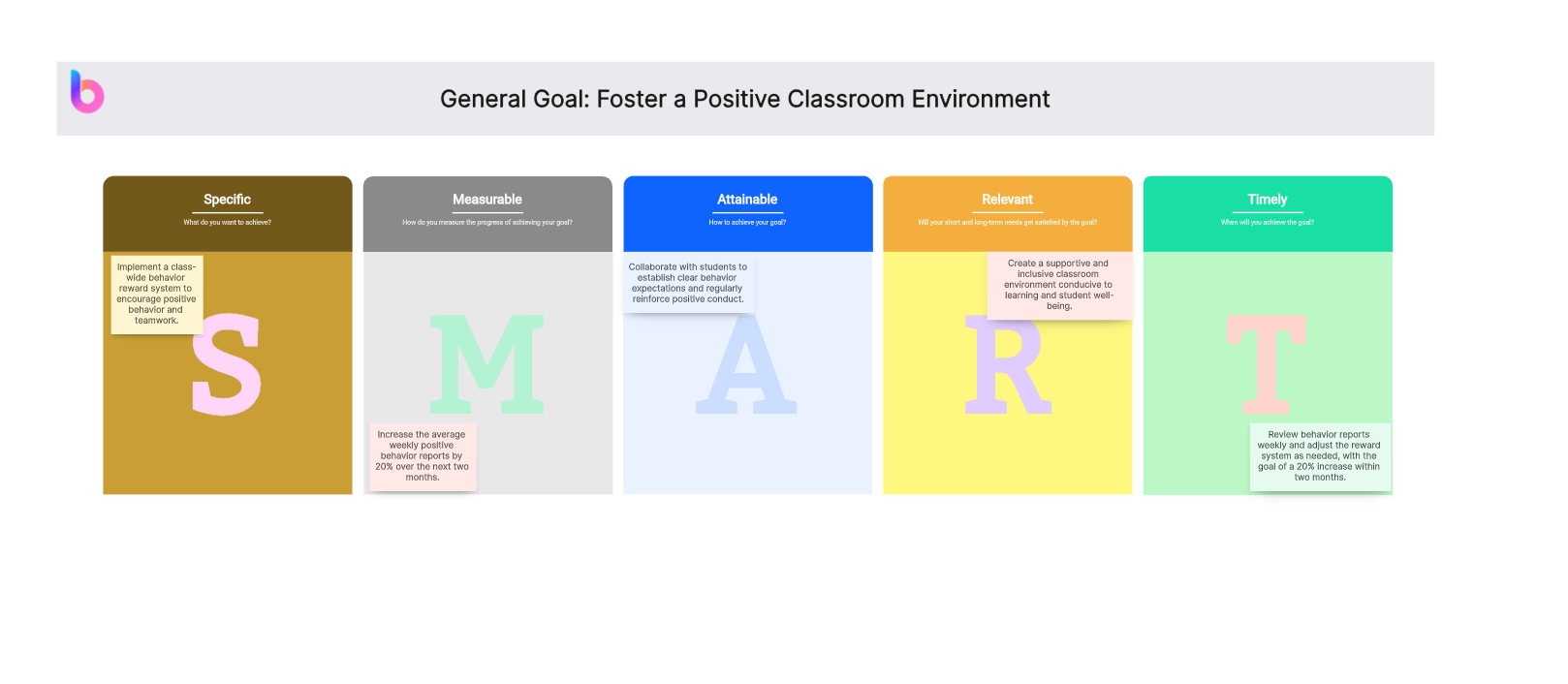
SMART Goals Example for Math Teachers
General Goal: Improve Student Problem-Solving Skills
- Specific (S): Incorporate problem-solving activities into every math lesson to enhance critical thinking skills.
- Measurable (M): Increase student success rates in solving complex math problems by 20% over the next grading period.
- Achievable (A): Provide additional resources, such as practice worksheets and online tools, to support students in developing problem-solving strategies.
- Relevant (R): Strengthen students' ability to apply mathematical concepts to real-world scenarios, fostering a deeper understanding of the subject.
- Time-bound (T): Evaluate student problem-solving success rates bi-weekly, with the goal of a 20% improvement by the end of the grading period
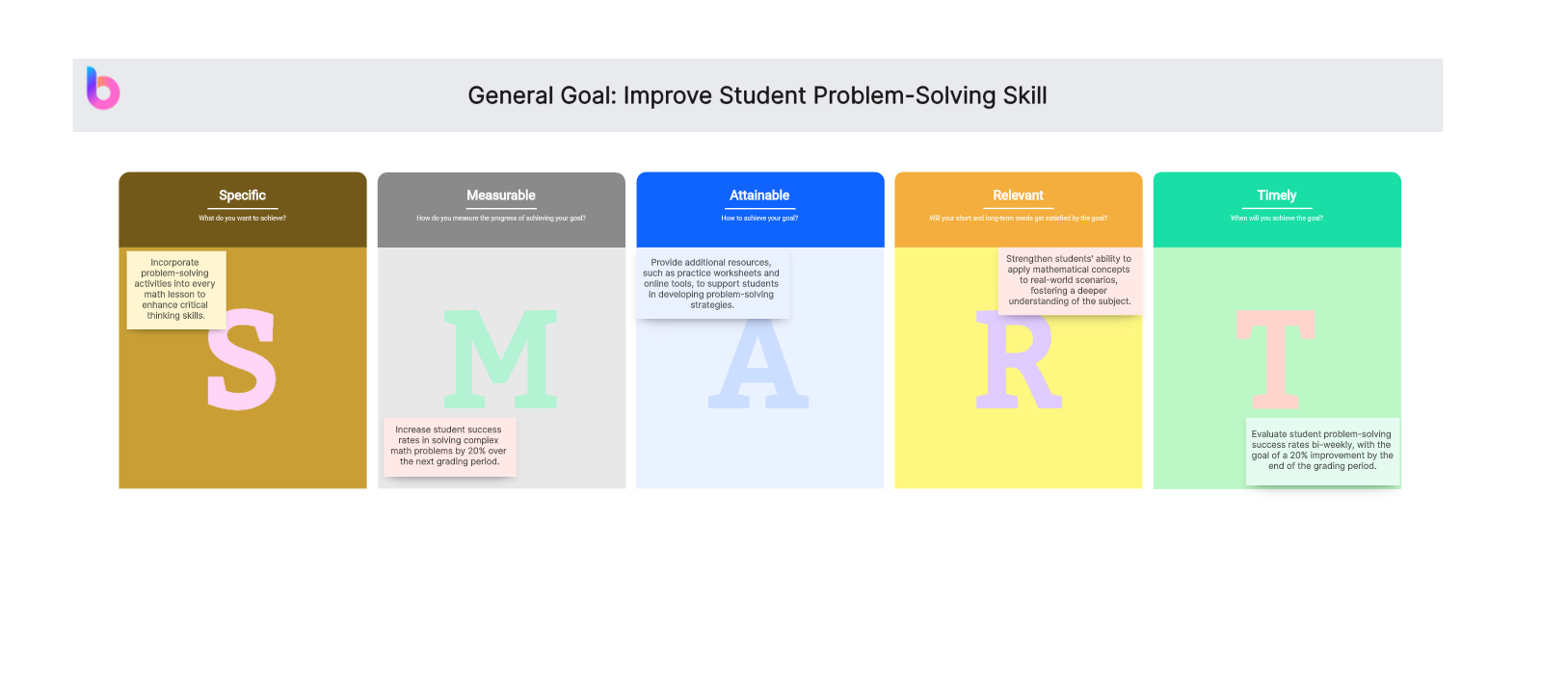
SMART Goals Example for Math Teachers
General Goal: Incorporate Technology in Math Instruction
- Specific (S): Integrate interactive math software into at least two lessons per week to enhance student engagement.
- Measurable (M): Increase student participation and interest in math lessons by 25% over the next quarter.
- Achievable (A): Provide training sessions for teachers on the effective use of math software and ensure access to necessary technology.
- Relevant (R): Equip students with essential digital literacy skills while making math lessons more dynamic and interactive.
- Time-bound (T): Monitor student engagement weekly, with the goal of a 25% increase in participation by the end of the quarter.
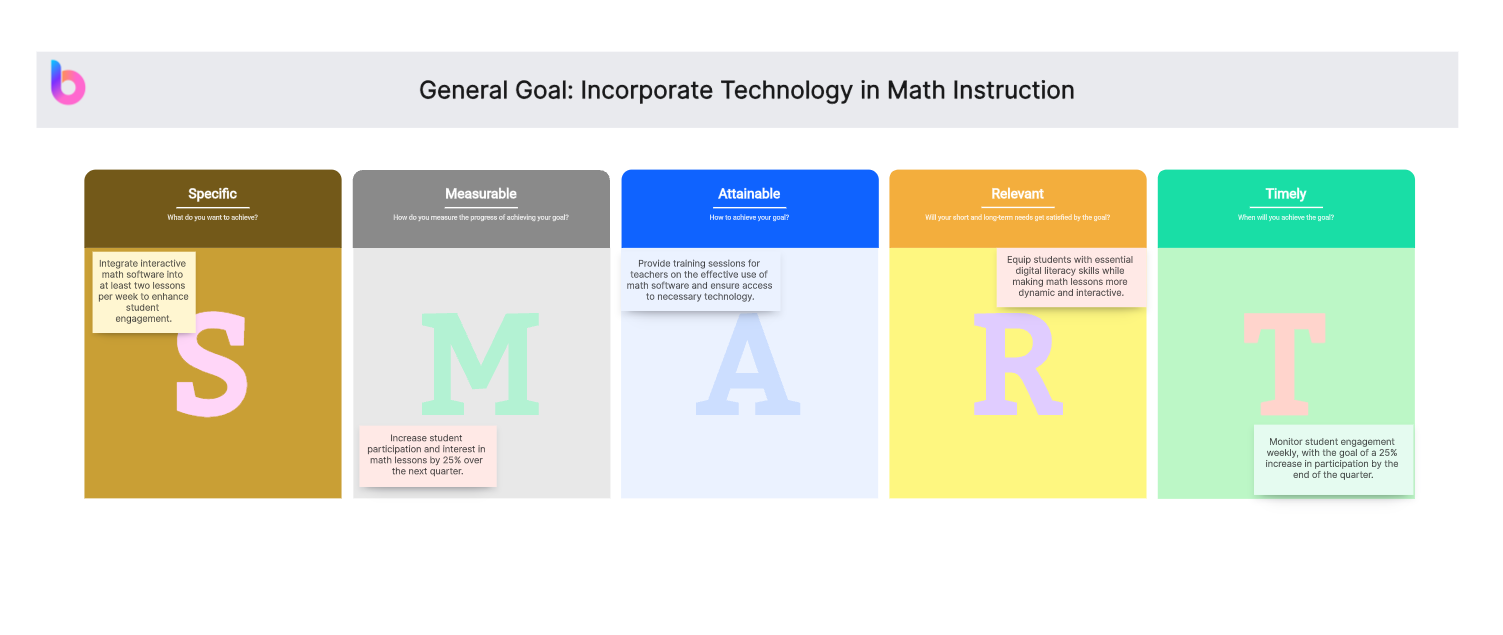
SMART Goals Example for Special Education Teachers
General Goal: Individualized Learning Plans (ILPs) Implementation
- Specific (S): Develop and implement ILPs for each student in the caseload, tailored to their unique learning needs.
- Measurable (M): Achieve a 15% improvement in academic performance based on pre- and post-assessment scores within the next semester.
- Achievable (A): Collaborate with other special education professionals and attend relevant workshops to enhance ILP development skills.
- Relevant (R): Address the diverse learning needs of students with special needs, promoting academic growth and overall development.
- Time-bound (T): Assess student progress monthly, with the goal of a 15% improvement in academic performance by the end of the semester.

SMART Goals Example for Special Education Teachers
General Goal: Enhance Communication with Parents and Caregivers
- Specific (S): Establish a consistent communication plan, including bi-monthly progress reports and regular parent-teacher conferences.
- Measurable (M): Increase parent/caregiver involvement in students' education by 20% over the next two months.
- Achievable (A): Provide resources and workshops to educate parents about supporting their child's education and maintaining regular communication channels.
- Relevant (R): Foster a collaborative partnership between teachers, parents, and caregivers to support the academic and social development of students with special needs.
- Time-bound (T): Evaluate parent/caregiver involvement bi-monthly, with the goal of a 20% increase within two months.

SMART Goals Example for New Teachers
General Goal: Classroom Management Proficiency
- Specific (S): Implement a comprehensive classroom management plan, including consistent rules and positive reinforcement strategies.
- Measurable (M): Reduce classroom disruptions by 30% over the next grading period.
- Achievable (A): Seek mentorship from experienced teachers, attend relevant workshops on classroom management, and practice consistent enforcement of rules.
- Relevant (R): Establish a positive and structured learning environment conducive to student engagement and academic success.
- Time-bound (T): Monitor and record classroom disruptions weekly, with the goal of a 30% reduction by the end of the grading period.
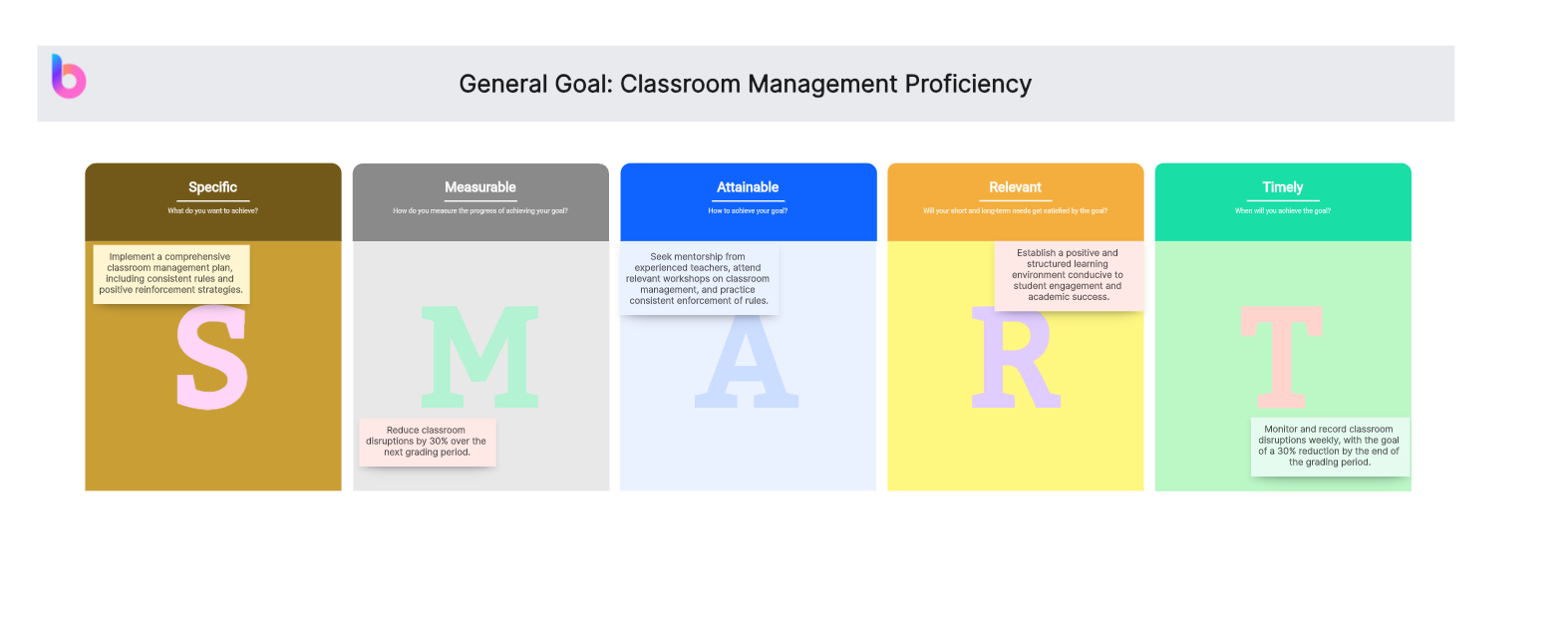
SMART Goals Example for New Teachers
General Goal: Professional Development and Networking
- Specific (S): Attend at least two professional development workshops and actively participate in one teacher networking event each month.
- Measurable (M): Expand professional knowledge and contacts, contributing to a 20% increase in instructional effectiveness.
- Achievable (A): Seek guidance from school mentors, explore online professional development opportunities, and actively engage in teacher forums.
- Relevant (R): Enhance teaching skills, stay updated on educational trends, and build a supportive professional network.
- Time-bound (T): Track attendance and participation in professional development and networking events monthly, with the goal of a 20% increase in instructional effectiveness within six months.

A One-stop SMART Goals Maker - Boardmix
Every educator recognizes the transformative power of well-articulated goals. They are the backbone of effective teaching and lay the groundwork for tangible growth in learners. And while goal-setting is a crucial part of every teacher’s arsenal, it often poses as an arduous task filled with ambiguity. That's where Boardmix steps in.
Boardmix is an innovative one-stop solution for creating SMART goals that enhance teaching methodologies and facilitate optimum student learning outcomes. At its core, Boardmix allows teachers to convert their broad objectives into Specific, Measurable, Achievable, Relevant, and Time-bound goals. This platform equips educators with a user-friendly interface, efficient tools, and a supportive community to turn abstract teaching aspirations into well-defined, actionable targets.
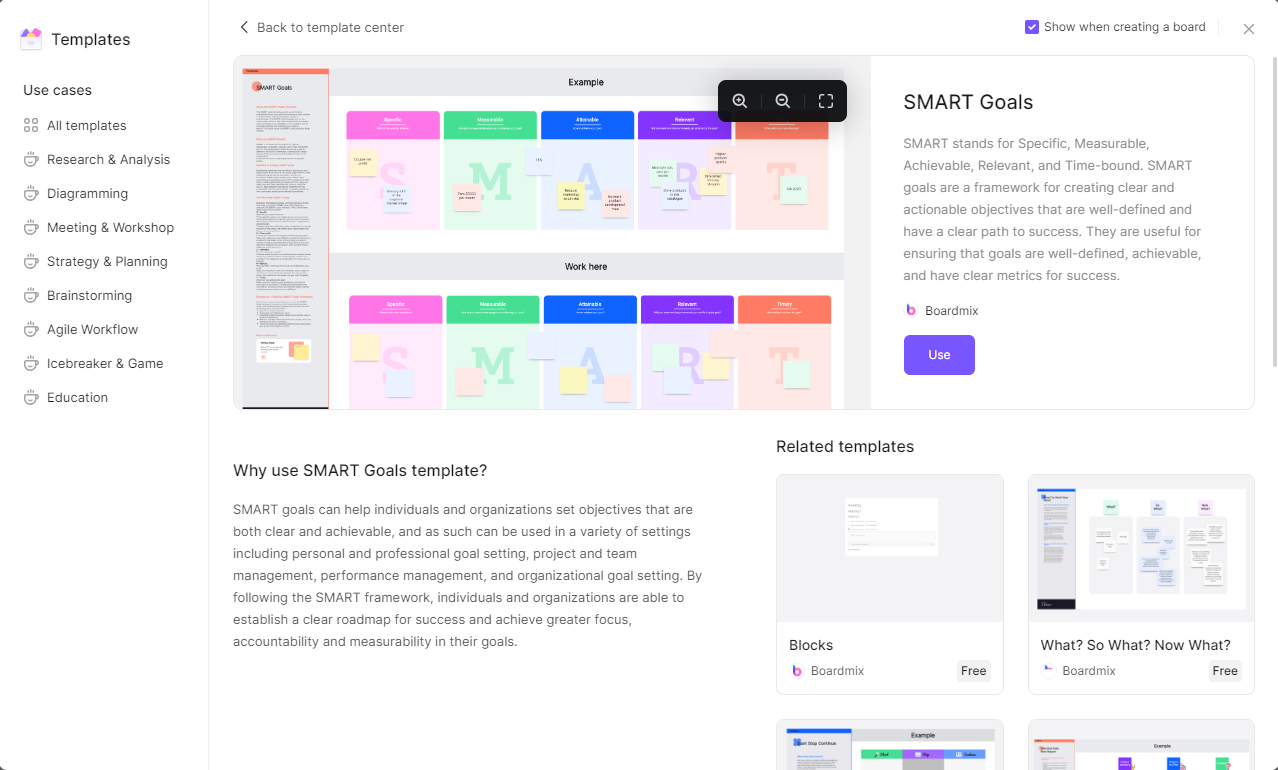
The platform's functionality hinges on three key features:
Guided Interface: A structured yet flexible user interface that walks teachers through each step of formulating a SMART goal.
Ready-made Templates: A wide range of ready-made templates can be used directly by teachers to set their SMART goals quickly and easily.
Task Management: With Boardmix's management tools, teachers can track their progress towards achieving the goal over time. This not only promotes accountability but also provides a chance to recalibrate strategies if needed.
Share and Learn: Finally, Boardmix facilitates knowledge exchange by encouraging users to share their SMART goals journey within its community of educators. This step nurtures professional growth through shared learning experiences.
Boardmix revolutionizes SMART goal creation for teachers by providing an easy-to-use, comprehensive platform that not only simplifies the process but also ensures teachers gain maximum value from their goals. So whether you are a new teacher or a seasoned veteran looking to make your teaching more targeted and effective, Boardmix is your perfect companion in the journey toward educational excellence.
Tips and Tricks on Setting SMART Goals for Teachers
In the world of education, goal-setting is a cornerstone for both teacher and student success. SMART goals, characterized by being Specific, Measurable, Achievable, Relevant, and Time-bound, are particularly effective. Here, we will walk you through a few handy tips and tricks on setting SMART goals as a teacher.
Tip 1: Understand Your Broad Objective
Before setting a SMART goal, clarify your broad objective. What area of your teaching practice or student learning do you want to improve? Once you have a clear picture of the end goal, it will be easier to transform it into a SMART goal.
Tip 2: Be Specific and Concrete
An effective SMART goal is specific and concrete. Instead of setting a general goal like 'Improve class participation,' set a specific goal like 'Increase student participation in class discussions by 20% by implementing interactive teaching methods over the next term.'
Tip 3: Measure Progress Quantitatively
Measurable goals offer a concrete method to determine how much progress has been made. Use quizzes, tests, feedback, and other evaluation tools to set baseline data, track progress, and confirm when the goal has been achieved.
Tip 4: Set Realistic Expectations
While it’s good to aim high, make sure your goals are achievable. An unattainable goal can lead to unnecessary stress and self-criticism. Consider the resources at your disposal, including time, money, materials, and support when setting your goals.
Tip 5: Align Goals with Larger Vision
Relevance is an essential component of SMART goals. Align your goals with broader objectives, such as your professional development plans or your school's mission statement. This alignment ensures that your efforts contribute towards meaningful growth.
Tip 6: Define a time frame
Time-bound goals fuel momentum by establishing a sense of urgency. Define when you plan to achieve your goal – this could range from a few weeks to an academic year. A set timeline brings focus and fosters accountability.
Tip 7: Review and Adjust
Setting a goal is not a one-time activity. Continually review your progress and adjust your plans as necessary. Remember that the primary purpose of setting SMART goals is growth and improvement, not rigid adherence to an initial plan.
Tip 8: Stay Consistent and Persevere
Achieving your goals takes time, consistency, and perseverance. Encountering obstacles is part of the journey. Stay committed to your goal, adjust strategies when needed, but never lose sight of your overarching objective.
Setting SMART goals is a powerful way for teachers to enhance their effectiveness, foster student learning outcomes, and promote continuous professional growth. With these tips and tricks, you can confidently set SMART goals that catalyze impactful change in your teaching journey.













